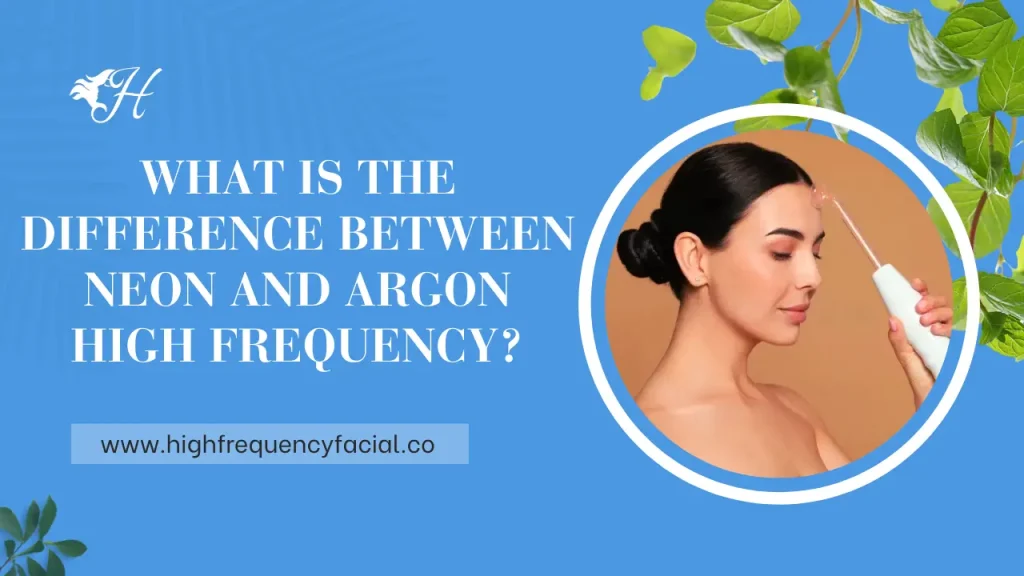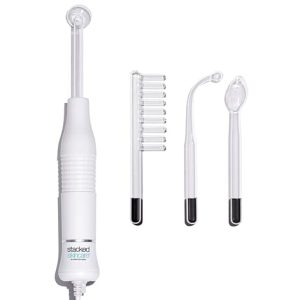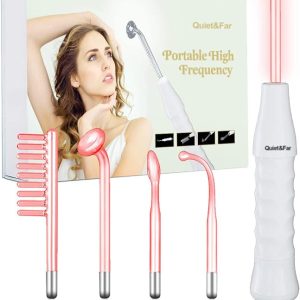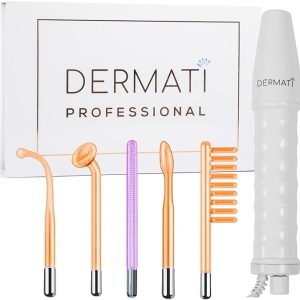Understanding the difference between neon and argon gas electrodes in high frequency (HF) treatments is crucial for both hair and skin care.
Neon electrodes stimulate scalp circulation for hair growth and aid in skin rejuvenation, while argon electrodes soothe scalp irritation and reduce skin inflammation.
This knowledge helps individuals choose the right HF treatment for their specific hair and skin concerns, ensuring effective and comprehensive care.


What is the Difference Between Neon and Argon High Frequency?
Neon and argon high-frequency lights differ primarily in the gases they use to produce light. Neon emits a red-orange glow, while argon produces a blue-violet light.
| Aspect | Neon Laser in Skincare | Argon Laser in Skincare |
|---|---|---|
| Penetration Depth | Shallow penetration | Deeper penetration |
| Targeted Issues | Superficial concerns | Deeper skin conditions |
| Typical Uses | Redness reduction | Pigmentation treatment |
| Efficacy | Limited to surface issues | Addresses deeper problems |
| Skin Concerns Addressed | Mild redness, fine lines | Pigmentation, scars |
How Do Neon And Argon Gases Work During The HF Treatment?
The mechanism of high-frequency treatment with argon and neon gases involves the production of controlled electrical currents through a glass electrode. Here’s a simplified explanation for each gas:
Argon Gas Mechanism:
- Electrical Current Generation: When the high-frequency machine is turned on, it produces a high-frequency alternating current.
- Argon Gas Interaction: The current flows through a glass electrode filled with argon gas.
- Gas Excitation: The electrical energy excites the argon atoms, causing them to emit ultraviolet (UV) light and produce ozone.
- Penetration into Skin Tissues: The UV light and ozone have a bactericidal effect, killing acne-causing bacteria on the skin.
- Deeper Penetration: Due to its smaller atomic size, argon penetrates deeper into the skin.
Neon Gas Mechanism:
- Similar Electrical Current Generation: Like argon, neon high-frequency treatment begins with the generation of a high-frequency alternating current.
- Neon Gas Interaction: The current passes through a glass electrode containing neon gas.
- Gas Excitation: The electrical energy excites the neon atoms, causing them to emit a visible red-orange light.
- Surface-Level Treatment: Neon high-frequency is effective for surface-level concerns. The emitted light has a mild germicidal effect, helping with issues like mild redness and fine lines.
- Limited Penetration: Neon gas, with its larger atomic size compared to argon, has limited penetration into the skin.
Which Is Better: Argon vs Neon Gas?
The preference between neon and argon depends on the specific skin concerns.
Neon high-frequency treatments are generally more effective for addressing superficial issues like mild redness and fine lines. The neon gas is versatile for surface-level improvements, making it suitable for a range of mild skin conditions.
On the other hand, argon high-frequency treatments are designed for deeper penetration, making them more effective in addressing skin issues that go beyond the surface. Argon is particularly well-suited for treating pigmentation problems and scars, providing more comprehensive results for conditions requiring deeper attention.
Therefore, the choice between neon and argon high-frequency treatments depends on the depth and nature of the skin concerns one aims to address.
Fow What Concern To Use Argon and Neon Gas?
Here are some skin/hair concerns and the suitable gas for each:
| Concern | Suitable Gas |
|---|---|
| Mild Redness and Fine Lines (Skin) | Neon |
| Hyperpigmentation, Dark Spots, and Sun Damage | Argon |
| Acne Scars and Post-Inflammatory Hyperpigmentation | Argon |
| Uneven Skin Texture and Large Pores (Skin) | Neon or Argon |
| Wrinkles and Deep Lines (Skin) | Argon |
| General Skin Rejuvenation (Skin) | Neon or Argon |
| Dry Scalp and Dandruff (Hair) | Neon |
| Hair Loss and Thinning (Hair) | Argon |
| Overall Scalp Health (Hair) | Neon or Argon |


Benefits of Using Neon Gas For High Frequency:
Neon gas in high-frequency treatments offers several benefits:
- Gentle Stimulation: Neon is excellent for mild skincare concerns. It provides a gentle electrical stimulation, making it suitable for individuals with sensitive skin.
- Surface-Level Improvement: Ideal for addressing mild redness, fine lines, and superficial skin issues. Neon works effectively on the outer layer of the skin, offering visible improvements.
- Versatility: Neon is versatile and can be applied to various skin types. It’s a go-to choice for general skin rejuvenation without causing significant discomfort.
- Quick Treatments: Neon high-frequency treatments are often quicker, making them convenient for individuals with busy schedules seeking efficient skincare solutions.
Benefits of Using Argon Gas For High Frequency:
This gas is particularly effective in addressing various skincare concerns with a direct and confident approach:
- Deeper Penetration: Argon goes beneath the skin surface, making it highly effective for treating deep-seated issues like pigmentation problems, scars, and wrinkles.
- Enhanced Tissue Healing: The deep penetration of argon aids in stimulating collagen production, promoting tissue healing, and contributing to a smoother, rejuvenated skin appearance.
- Improved Blood Circulation: Argon’s action helps enhance blood circulation, fostering better nutrient delivery to skin cells and supporting overall skin health.
- Versatility: Argon is versatile and suitable for a range of concerns, making it a go-to gas for addressing multiple skincare issues comprehensively.
How To Do High Frequency Treatment Using Argon or Neon Gas?
Here are concise tips for using argon/neon gas in high-frequency treatments:
- Cleanse Thoroughly: Start with clean skin for better argon/neon gas penetration.
- Choose the Right Attachment: Select the attachment that suits your skincare goal.
- Start Low, Go Slow: Begin with a low intensity and gradually increase.
- Gentle Circular Motions: Move the wand gently in circles to distribute the gas evenly.
- Follow a Pattern: Systematically cover the treatment area without excessive overlap.
- Use Conductive Gel: Apply gel for better gas conductivity.
- Mind Treatment Frequency: Be mindful of how often you use argon/neon gas, depending on your skin’s response.
- Post-Treatment Care: Apply a soothing product after treatment and follow a proper aftercare routine.
- Seek Professional Advice: Consult a skincare professional if you face any side effects.
Conclusion:
To sum it up, choosing between neon and argon gas for high-frequency treatments is important for dealing with different skin and hair problems.
Neon is good for small issues like redness, while argon works better for deeper concerns like pigmentation. Pick what fits your needs. Talking to experts will help you make the right choice for the best results.





